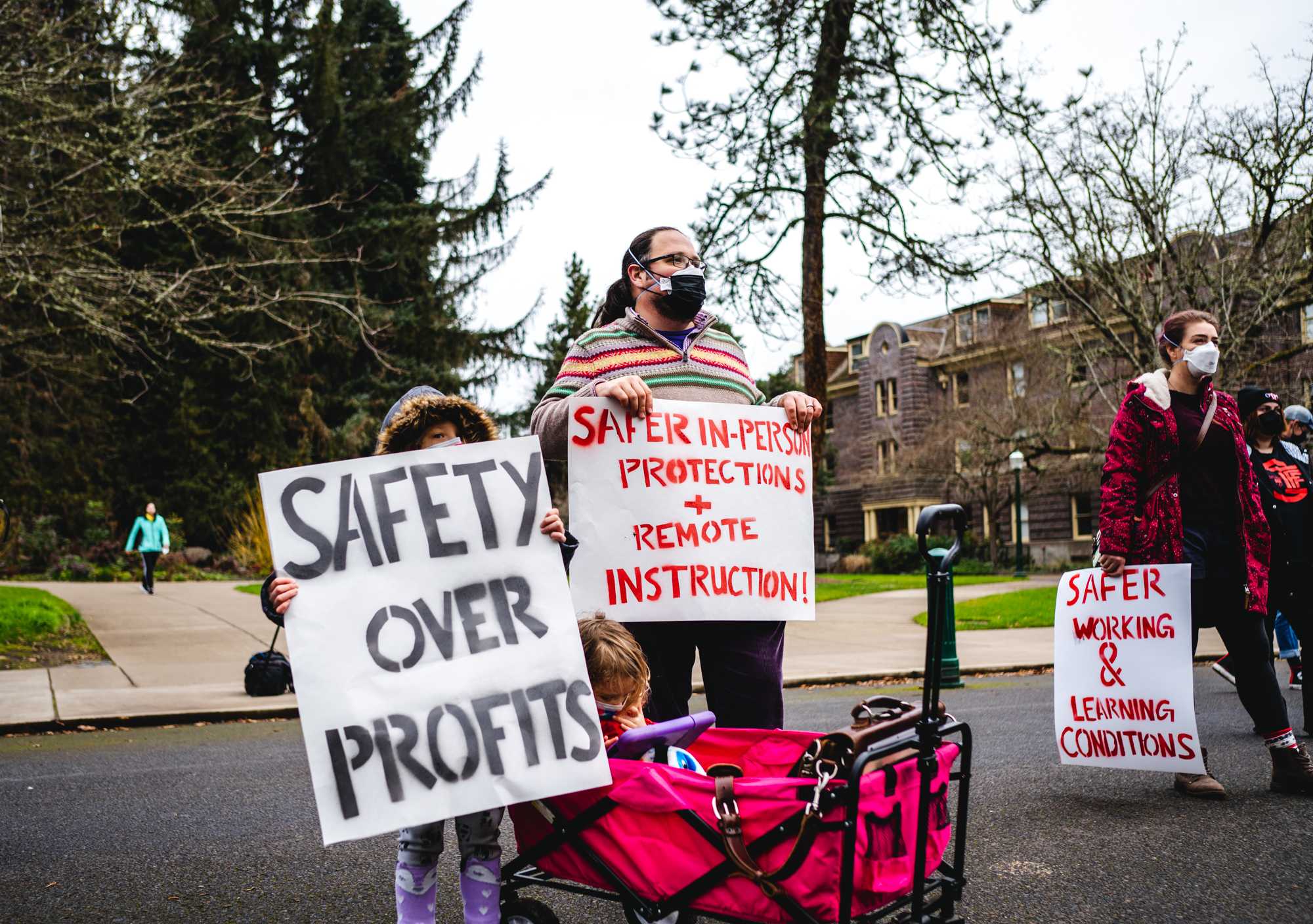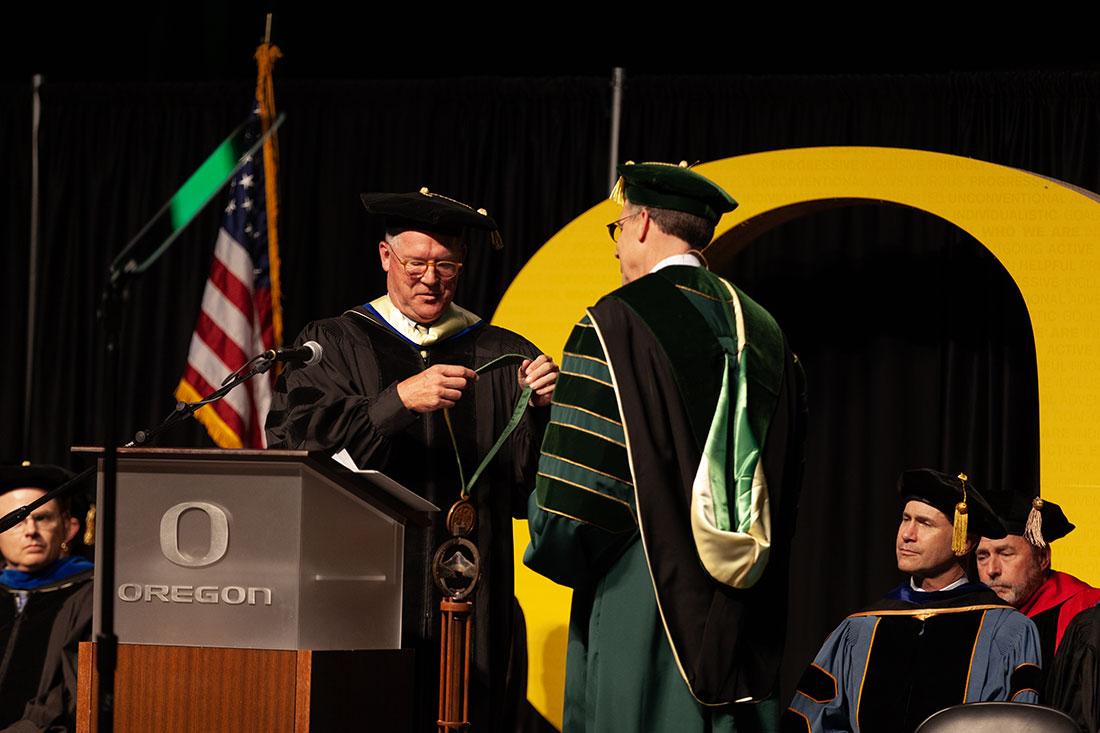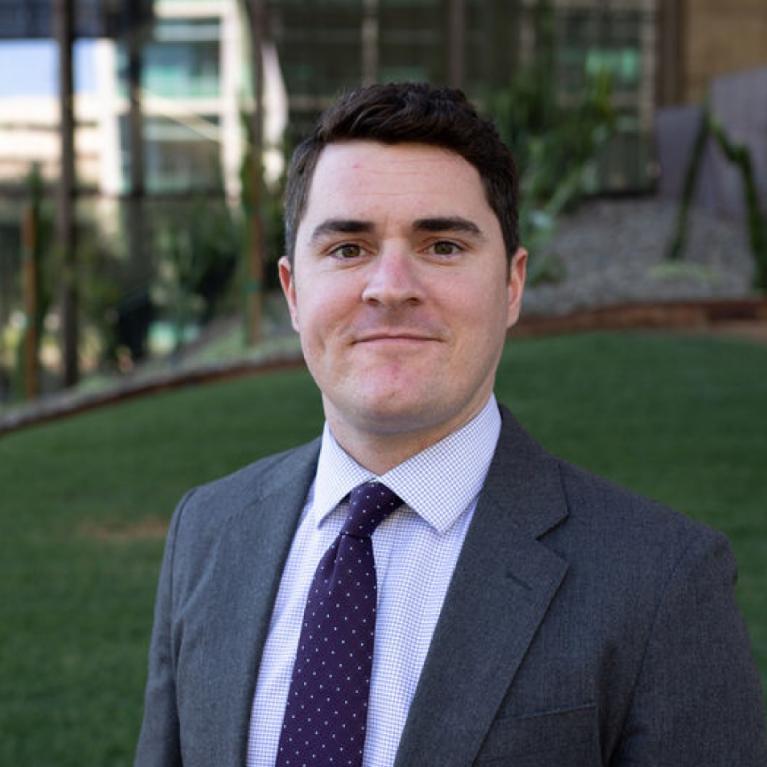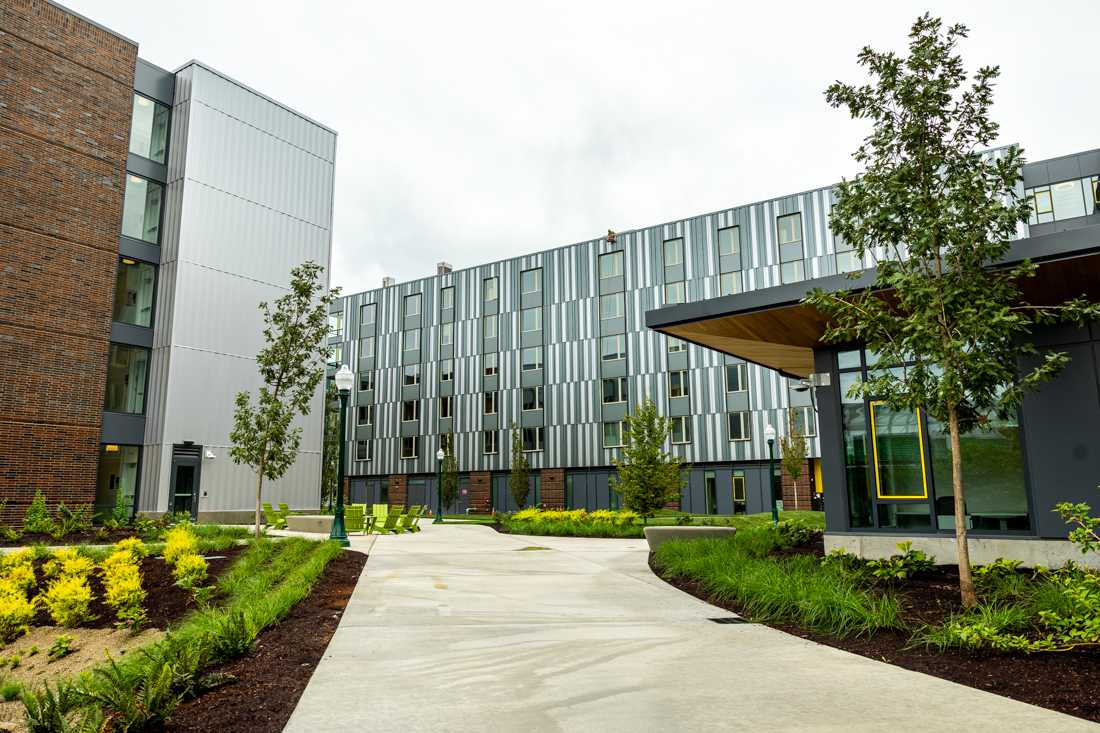It started with a meeting.
The University of Oregon and the Graduate Teaching Fellows Federation are in a constant state of negotiations and communications. But when Rajeev Ravisankar, the GTFF president from June 2020 to June 2021, thinks about the relationship between UO and GTFF throughout the pandemic, he thinks of the UO board of trustees meeting on March 17, 2020.
At the time, Oregon public officials called for limited indoor gatherings due to the spread of the coronavirus. But the board went through with the scheduled in-person meeting anyway. Members of several campus groups, including GTFF, held a demonstration outside the Ford Alumni Center, where the meeting took place. Four student protesters stood outside the doors in white medical suits and masks, urging the board not to hold the meeting, and two were pushed aside by the board’s chairman Chuck Lillis, the Insurgent reported.
Ravisankar reflected on this day at a Jan. 21 GTFF “speakout” demonstration outside of Johnson Hall, UO’s administration building.
“The incident is representative of the thrust of UO admin’s response to COVID,” he said to the crowd. “They have steamrolled their way through the pandemic by announcing decisions as they please and arrogantly staking out a position that what they’re doing is right, despite repeatedly falling short in attaining even the most basic conditions needed to ensure a safe campus.”
Ravisankar said there are four areas where UO is still lacking in the COVID-19 response: an abundance of high-quality masks, comprehensive testing and reporting mechanisms, consistent safety compliance on campus and flexibility and accommodations for workers.
UO spokesperson Saul Habbaud said UO continuously adapts to new information to respond to COVID-19 needs. “Members of the UO’s Incident Management Team (IMT) for COVID-19 have worked in close coordination with local, state, and federal public health agencies since February 2020,” Hubbard wrote in an email. “The IMT has also consistently included stakeholders from a wide range of departments across campus and consulted with student and employee groups as well as peer institutions — especially other public universities within Oregon — as it navigates COVID-19 in a university setting.”
GTFF represents over 1,400 graduate employees on campus. The Emerald spoke to the three GTFF presidents who have served throughout the pandemic about COVID-19 demands like these, as well as if and how they’ve been met. While its leaders say the union is not taken seriously and not included in negotiation processes, records show pressure from the union and significant UO COVID-19 decisions do have a correlation. Causation is more complicated to assess.
Mel Keller, GTFF president since October 2021 said UO “will make it seem like this policy has been in the works for a while, and there was no connection or no specific pressure from the GTFF, even though the timelines would suggest differently.”
Making masks accessible
GTFF has been pushing for appropriate personal protective equipment since the pandemic’s onset, Ravisankar said.
The union underscored the importance of personal protective equipment in an August 2020 letter to UO, saying UO’s focus on plans for an in-person fall 2020 left GEs who needed to be on campus in unsafe working conditions “uneven compliance with specific lab safety plans, lack of quarantine requirements when they or others return after travel, the failure of UO to provide adequate PPE, and the failure to enforce masking and other safety protocols.”
UO ended up moving the fall 2020 term to mostly remote learning and made branded cloth masks available on Sept. 28, 2020 through “wellness kits,” which included two masks, one thermometer, one hand sanitizer and a symptom self-check sheet.

About a year later, at the beginning of the fall 2021 term, GTFF continued their demands for PPE, requesting N95s, KN95s or KF94s be provided to every GE and student with instructions on how to wear them, especially in light of CDC mask guidance for the Omicron variant.
This request went unanswered. That is, until GTFF restated the demand in a Jan. 17 letter and organized a rally outside of Johnson Hall on Jan. 18. UO announced it would offer KN95 masks that same day.
“It’s amazing how quickly these things happen when people come together to say, ‘Hey, we need better,’” Miche Dreiling, GTFF president from June to October 2021, said.
Getting shots in arms
In the summer of 2020, much remained up in the air about the vaccine mandate.
“When we were in discussions with the university about what the vaccine mandate might look like, they were very fixated on a different mandate between students and employees,” Dreiling said. They said the plan did not account for GEs, who fall in the intersection between student and faculty.
Ultimately, UO’s vaccine mandate, issued May 10, 2021, applied equally to students and employees.
 A large sign hangs over Autzen to encourage and congratulate those who are doing their part to keep the community safe. University of Oregon begins to distribute Vaccines to Students and Faculty on April 21, 2021. (Maddie Stellingwerf/Emerald)
A large sign hangs over Autzen to encourage and congratulate those who are doing their part to keep the community safe. University of Oregon begins to distribute Vaccines to Students and Faculty on April 21, 2021. (Maddie Stellingwerf/Emerald)
When the time came to consider a booster shot mandate, GTFF asked UO to hold a booster clinic to ensure access. This request was listed in those same Jan. 17 demands.
In an email on Jan. 24, UO announced it will hold a walk-up booster clinic at Autzen stadium starting Jan. 25.
Operations and access
From that board of trustees meeting in March 2020 to Dec. 3, 2021, board meetings have lacked a public comment section.
This is part of the trend of excluding GEs from decision-making processes, Ravisankar said. Of the board of trustees’ 15 members, one is an undergraduate student and zero are graduate students.
Hubbard said UO consults with campus departments, student and employee groups and other universities to make COVID-19 decisions.
In fall 2020, GTFF requested to have significant representation in the decision-making process for reopening. UO offered a one hour meeting every other week, with an “update” from administration and 30 minutes for questions and input.
“They will listen to our demands and engage on some of the things we bring up, but only if there is public pressure to do so,” Keller said. “They don’t see us as a serious bargaining unit and a serious group of workers that they have to negotiate with, which is why oftentimes, the GTFF is kind of on its back foot, responding to things rather than proactively dealing with them.”
From the pandemic’s outset, GTFF has called for fair and safe decisions — but also quick decisions.
As the union pointed out in fall 2020, “maintaining an in-person posture for fall term during the past several months has sent a signal to students and other university constituents that they should be making plans for returning or moving to Eugene, despite the major threats to community safety that this poses.”
In winter 2022, UO reached a record number of weekly cases: 961 cases from Jan. 3-9 followed by 631 cases Jan. 10-16 and 378 cases Jan. 17-23.
The COVID-19 spike highlighted a long-standing issue for GTFF regarding flexibility and allowing instructors to feel safe and comfortable when conditions change, Ravisankar said.
GTFF demanded UO move classes online for two weeks to mitigate the consequences of the Omicron surge in a letter on Jan. 5.
On Jan. 6, UO Provost Patrick Phillips issued an announcement that classes could be held in a hybrid format: Professors could request to hold classes virtually if over 20% of students enrolled in a course contracted COVID-19.
Onward and upward
Moving forward, the UO community needs to reflect on this pandemic experience and continue to advocate for safe and fair spaces to learn and work, Ravisankar said in his Jan. 21 speech.
“Decisions are handed down, and we deal with them, for better or worse, in our departments and as individuals,” he said. “But we have the tools at our disposal to transform the situation. It won’t happen with one or even 10 actions, but with deep organizing and through a network of on- and off-campus actors who can strategically pressure the UO admin through different channels.”







